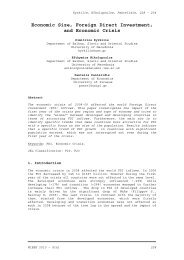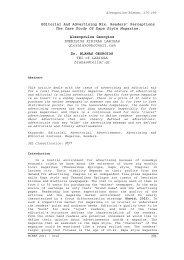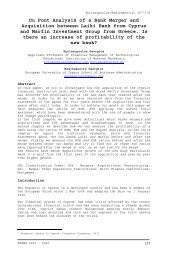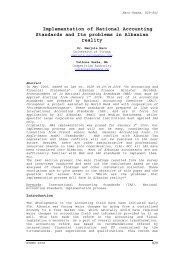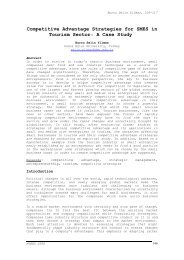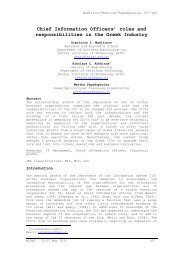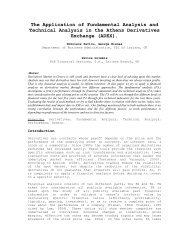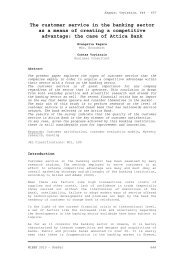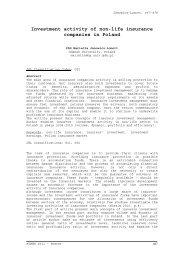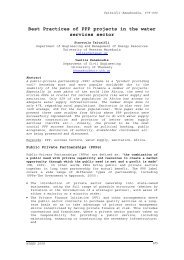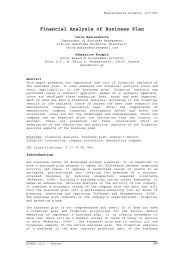Decisionâmaking process under risk and uncertainty â the ... - mibes
Decisionâmaking process under risk and uncertainty â the ... - mibes
Decisionâmaking process under risk and uncertainty â the ... - mibes
You also want an ePaper? Increase the reach of your titles
YUMPU automatically turns print PDFs into web optimized ePapers that Google loves.
Tsinani, Šević, Maditinos, 514 - 524<br />
Decision-Making Process <strong>under</strong> Risk <strong>and</strong><br />
Uncertainty<br />
The Role of Managerial Optimism:<br />
A Theoretical Approach<br />
Alex<strong>and</strong>ra Tsinani<br />
Glasgow Caledonian University<br />
Business School<br />
atsina10@caledonian.ac.uk<br />
Željko Šević<br />
Glasgow Caledonian University<br />
Business School<br />
Zeljko.Sevic@gcal.ac.uk<br />
Dimitrios Maditinos<br />
Technological Educational<br />
Institute of Kavala, Business School<br />
dmadi@teikav.edu.gr<br />
Abstract<br />
Does managerial optimism help to explore <strong>and</strong> <strong>under</strong>st<strong>and</strong> corporate<br />
decision-making <strong>process</strong> <strong>under</strong> <strong>risk</strong> <strong>and</strong> <strong>uncertainty</strong>? How decisionmakers<br />
perceive <strong>risk</strong> <strong>and</strong> how this perception affects firm’s real<br />
outcomes? These are only a few questions that have intrigued us to<br />
investigate in depth <strong>the</strong> context of behavioural corporate finance,<br />
decision-making <strong>process</strong> as well as <strong>uncertainty</strong> <strong>and</strong> <strong>risk</strong>; some major<br />
<strong>the</strong>mes in finance <strong>and</strong> economics. In this study we try to investigate<br />
some important aspects of <strong>the</strong> <strong>the</strong>oretical background as a startingpoint<br />
for fur<strong>the</strong>r research. Some of <strong>the</strong> most important published<br />
studies are presented along with results, methodologies <strong>and</strong><br />
statistical measures.<br />
Keywords: Managerial optimism, decision-making, behavioural corporate<br />
finance, self-attribution bias, business performance<br />
JEL Classifications: D80, D81, G32<br />
1. Introduction<br />
Corporate investment decisions are among <strong>the</strong> most important decisions<br />
that firms have to deal with. To fully <strong>under</strong>st<strong>and</strong> <strong>the</strong> investment<br />
decision <strong>process</strong> we have to focus on investment measures such as<br />
capital expenditures, investments in advertising, R&D <strong>and</strong> intangible<br />
assets (Glaser et al., 2008) or <strong>the</strong> impact of mergers <strong>and</strong><br />
acquisitions on shareholder wealth. Investment decision <strong>process</strong><br />
encompasses <strong>risk</strong>. Managers have to make decisions that are more or<br />
MIBES 2010 – Poster 514
Tsinani, Šević, Maditinos, 514 - 524<br />
less <strong>risk</strong>y. Moreover, better decisions are made when <strong>the</strong>re is<br />
sufficient knowledge regarding <strong>the</strong> mechanism of decision making as a<br />
great step to <strong>risk</strong> control management. How managerial optimism as<br />
well as o<strong>the</strong>r psychological biases affect a firm’s investment<br />
decision <strong>process</strong>? Is <strong>the</strong>re an optimum procedure <strong>risk</strong> – averted or not<br />
in order to achieve <strong>the</strong> best investment opportunities for a firm?<br />
These are <strong>the</strong> main questions we tackle in this paper in order to read<br />
into <strong>the</strong> investment decision <strong>process</strong>.<br />
People, including managers <strong>and</strong> business leaders, normally associate<br />
<strong>the</strong> quality of a decision with <strong>the</strong> quality of <strong>the</strong> result. When<br />
managers observe a good result, <strong>the</strong>y believe that <strong>the</strong>y made a good<br />
decision. However, decisions <strong>and</strong> results are two different things.<br />
Decisions are made at a specific moment in time; in <strong>the</strong> event, people<br />
apply <strong>the</strong>se decisions, <strong>and</strong> <strong>the</strong> result is observed in <strong>the</strong> future which<br />
seems normally uncertain. In <strong>the</strong> future, events can happen that<br />
managers <strong>and</strong> firms cannot control. Moreover, events can happen that<br />
managers cannot foresee. Such events can cause good decisions to have<br />
a bad result — <strong>and</strong> vice versa. Therefore, <strong>the</strong> quality of <strong>the</strong> result<br />
is not demonstrative of decision quality, <strong>and</strong> <strong>the</strong> result is<br />
irrelevant as a measure of decision quality.<br />
Of course, results are not irrelevant for firms <strong>and</strong> managers. The<br />
manager is eventually responsible for <strong>the</strong> good results for <strong>the</strong> firm,<br />
a responsibility to <strong>the</strong> stockholders who dem<strong>and</strong> good results. But<br />
what can firms do to achieve good results? Firms usually do two<br />
things to achieve, on average, better results. First of all, <strong>the</strong>y<br />
implement a good <strong>process</strong>. Managers have to learn to become better<br />
business executives. They can learn <strong>the</strong> <strong>process</strong> of decision making,<br />
learn how to be better in performance <strong>and</strong> manage <strong>the</strong>ir firm via<br />
knowledge <strong>and</strong> experience which are imperative in decision making<br />
<strong>process</strong>. Second, firms try to manage <strong>the</strong> <strong>risk</strong> in any single business<br />
project. That is why <strong>the</strong> manager must be act responsibly for <strong>the</strong><br />
overall results of <strong>the</strong> firm.<br />
The starting point when analysing corporate investment policy<br />
decisions is commonly that a firm’s investment should depend<br />
exclusively on <strong>the</strong> profitability of its investment opportunities.<br />
However, <strong>the</strong> evidence over <strong>the</strong> last years strongly shows investment<br />
depends on cash flow too (investment – cash flow sensitivity). A rush<br />
of cash flow leads to <strong>the</strong> result that managers invest too much<br />
(Glaser et al., 2008). Based on <strong>the</strong> asymmetric information <strong>the</strong>ories<br />
anyone might realise that managers <strong>the</strong>mselves restrict external<br />
financing in order to avoid issuing <strong>under</strong>valued shares. Recently many<br />
behavioural corporate finance <strong>the</strong>ories have been found based on<br />
managerial biases in order to explain corporate decisions. Although<br />
<strong>the</strong>re is a huge behavioural finance literature in investor behaviour,<br />
<strong>the</strong>re is a little empirical research in behavioural corporate<br />
finance.<br />
MIBES 2010 – Poster 515
Tsinani, Šević, Maditinos, 514 - 524<br />
According to Tombaugh (2005) optimistic managers are more likely to<br />
see problems as challenges as well as opportunities, strive for<br />
longer periods to reach <strong>the</strong>ir goals, <strong>and</strong> search for <strong>and</strong> appreciate<br />
<strong>the</strong> positive aspects of difficult situations. Therefore, optimism<br />
generally influences work <strong>and</strong> eventually firm performance. Does<br />
managerial optimism play an important role in corporate decision<br />
making? Do overconfident managers act in <strong>the</strong> interests of <strong>the</strong>ir<br />
shareholders preserving <strong>the</strong>ir wealth? The overconfidence hypo<strong>the</strong>sis<br />
states that managers are simply overconfident <strong>and</strong> over-invest (Doukas<br />
<strong>and</strong> Petmezas, 2007). They claim that are superior <strong>and</strong> more powerful<br />
than o<strong>the</strong>rs. However, due to <strong>the</strong>ir overconfidence profile <strong>the</strong>y tend<br />
to devaluate <strong>the</strong> <strong>risk</strong>s <strong>and</strong> often make destructive decisions for <strong>the</strong>ir<br />
firm. Therefore is overconfidence driven by managers’ self<br />
attribution bias? All <strong>the</strong> above questions are going to occupy us<br />
trying to <strong>under</strong>st<strong>and</strong> <strong>the</strong> power of managerial optimism in decision<br />
making <strong>process</strong> <strong>and</strong> <strong>the</strong> existence of self-attribution bias while<br />
tackling corporate investment policy decisions.<br />
J. B. Heaton (2002), stated that two extremely important features<br />
emerge from a simple model of corporate finance with optimistic<br />
managers <strong>and</strong> efficient capital markets. First, optimistic managers<br />
state that capital markets <strong>under</strong>value <strong>the</strong>ir firm's <strong>risk</strong>y securities,<br />
<strong>and</strong> may decline positive net present value projects that must be<br />
financed externally. Second, optimistic managers overvalue <strong>the</strong>ir own<br />
corporate projects <strong>and</strong> may want to invest in negative net present<br />
value projects even though <strong>the</strong>y are feeling loyal to <strong>the</strong>ir<br />
shareholders eventually being related to free cash flow without<br />
appealing to asymmetric information or rational agency costs.<br />
2. Theoretical background<br />
Since <strong>the</strong> seminal work of Modigliani <strong>and</strong> Miller (1958), much research<br />
effort has been directed at <strong>under</strong>st<strong>and</strong>ing firms’ capital structure<br />
<strong>and</strong> investment decisions, <strong>and</strong> <strong>the</strong> corresponding effects on firm value<br />
(Fairchild, 2007). Until recently, <strong>the</strong> st<strong>and</strong>ard approach was to<br />
assume rationality of managers <strong>and</strong> investors. A large part of<br />
research examines <strong>the</strong> role of signalling regarding informational<br />
asymmetries in a rational framework (Lel<strong>and</strong> <strong>and</strong> Pyle 1977; Ross<br />
1977). Ano<strong>the</strong>r large part of research explores <strong>the</strong> use of capital<br />
structure to mitigate agency problems (Jensen <strong>and</strong> Meckling 1976;<br />
Jensen 1986; Fairchild 2003). This approach assumes a principal-agent<br />
problem based on selfish managerial rationality <strong>and</strong> overconfidence.<br />
The cognitive psychology literature argues that most people usually<br />
display optimistic expectations about <strong>the</strong> future. On one h<strong>and</strong>,<br />
individuals are more optimistic when <strong>the</strong>y believe that <strong>the</strong>y control<br />
positive outcomes <strong>and</strong> when <strong>the</strong>y are highly committed to <strong>the</strong>m<br />
(Weinstein, 1980). Managers on <strong>the</strong> o<strong>the</strong>r h<strong>and</strong> are more optimistic<br />
when <strong>the</strong>y control <strong>the</strong>ir firm’s performance <strong>and</strong> <strong>the</strong>y feel committed to<br />
this good performance because <strong>the</strong>ir personal wealth, employability as<br />
MIBES 2010 – Poster 516
Tsinani, Šević, Maditinos, 514 - 524<br />
well as reputation are highly dependent on it (March <strong>and</strong> Shapira,<br />
1987; Gilson, 1989). Given <strong>the</strong>ir leadership positions <strong>and</strong> managerial<br />
compensation, managers are likely to have an important impact on<br />
<strong>the</strong>ir firms’ success (Kaplan et al., 2008).<br />
There are many economic <strong>the</strong>orists that model managers or agents who<br />
run firms. Some of <strong>the</strong>m, like Holmstrom (1979) consider all managers<br />
or agents as being <strong>the</strong> same <strong>and</strong> mainly focus on effort supply.<br />
However in such <strong>the</strong>ories individual manager does not matter. Some<br />
o<strong>the</strong>r <strong>the</strong>orists consider managers as individuals having different<br />
talents <strong>and</strong> abilities which eventually influence firm’s performance.<br />
Are <strong>the</strong>refore personal characteristics of all senior managers<br />
toge<strong>the</strong>r perhaps a better indication of a firm’s decision making<br />
<strong>process</strong> than <strong>the</strong> CEO’s characteristics alone? This is <strong>the</strong> question<br />
that Glaser et al. (2008) tackle in <strong>the</strong>ir paper empirically for <strong>the</strong><br />
case of managerial optimism <strong>and</strong> corporate investment.<br />
Glaser et al. (2008) investigate how <strong>the</strong> exact decision <strong>process</strong> works<br />
within a firm, because corporate investment decisions are part of<br />
economic policy public conversation as economic development depends<br />
evidently on corporate investment. Behavioural corporate finance<br />
models are also being confirmed in <strong>the</strong>ir study since finding that<br />
managers are in fact optimistic <strong>and</strong> increase <strong>the</strong>ir exposure to<br />
company <strong>risk</strong>. Optimistic managers tend to invest more. However, <strong>the</strong><br />
possible case of overinvestment due to overconfidence <strong>and</strong> managerial<br />
optimism may be a source of long –run <strong>under</strong>performance.<br />
In his seminal paper regarding optimism Roll’s (1986) hubris<br />
hypo<strong>the</strong>sis suggests that managers share an overly optimistic opinion<br />
of <strong>the</strong>ir competence to create value. However, Billett <strong>and</strong> Qian (2005)<br />
stressed <strong>the</strong> importance of how do managers become overconfident. The<br />
psychology <strong>and</strong> behavioural economic literature <strong>under</strong>line selfattribution<br />
bias as <strong>the</strong> most common source of overconfidence. In<br />
Malmendier <strong>and</strong> Tate (2005) overconfidence is equal to overoptimism.<br />
Overoptimist managers overestimate <strong>the</strong> returns of <strong>the</strong>ir investment<br />
decisions <strong>and</strong> regard external funds excessively costly. Optimistic<br />
managers are at higher <strong>risk</strong> because <strong>the</strong>y use to overestimate <strong>the</strong><br />
future cash flows of <strong>the</strong>ir decisions.<br />
Behavioural corporate finance (BCF) examines <strong>the</strong> impact of managerial<br />
psychological biases on a firm’s corporate finance decision <strong>process</strong>.<br />
Traditionally, scholars have based <strong>the</strong>ir research assuming that<br />
managers are fully rational. However <strong>the</strong>y also recognised that<br />
psychological biases of managers affect decision – making in<br />
financial markets <strong>and</strong> firms. Consequently, behavioural finance has<br />
emerged as a challenge to <strong>the</strong> traditional example during <strong>the</strong> last<br />
years. Behavioural finance is a complete approach that connects<br />
finance, psychology <strong>and</strong> sociology. Financial psychology research has<br />
shown that human cognitive biases have many irrational components,<br />
even when humans try to make rational decisions. The cognitive<br />
MIBES 2010 – Poster 517
Tsinani, Šević, Maditinos, 514 - 524<br />
delusions <strong>the</strong>refore are more likely to affect investment decision<br />
<strong>process</strong> (Kahneman <strong>and</strong> Riepe, 1998).<br />
A very interesting aspect of BCF is <strong>the</strong> effect of group behaviour on<br />
decision – making. Groups usually amplify individual errors. This is<br />
an extremely significant finding for corporate managers, in that <strong>the</strong><br />
major part of firm investment decisions are made in groups. There are<br />
also many o<strong>the</strong>r behavioural applications to corporate finance besides<br />
group behaviour. For instance, overconfident managers may<br />
<strong>under</strong>estimate <strong>the</strong> probability of transgression, <strong>and</strong> as a result make<br />
investment decisions with overly debt – heavy capital structure. In<br />
<strong>the</strong> traditional approach to corporate finance managers tend to act as<br />
if markets were efficient. For example <strong>the</strong>re is a general acceptance<br />
that managers appear to act as if markets do have memory; managers<br />
like to take <strong>risk</strong>s <strong>and</strong> issue new stock only after <strong>the</strong> firm’s price<br />
has risen. Behavioural finance offers directive guidelines for<br />
managers when <strong>the</strong> stocks’ price is mispriced. These guidelines<br />
suggest that <strong>the</strong>re are some cases in which managers should regulate<br />
hurdle rates <strong>and</strong> o<strong>the</strong>r cases in which <strong>the</strong>y should not. From this<br />
point of view capital budgeting <strong>process</strong> <strong>and</strong> policy is more complex<br />
even when stock prices are efficient.<br />
Glaser et al. (2008) stressed that <strong>the</strong>re are two important <strong>and</strong><br />
necessary conditions for a positive relationship between managerial<br />
optimism <strong>and</strong> <strong>risk</strong> – taking, pure chance related <strong>risk</strong> <strong>and</strong> imprecise<br />
probabilities. Apparently, this means that <strong>the</strong>re is no relationship<br />
between optimism <strong>and</strong> <strong>risk</strong> – taking. However, in decision <strong>process</strong> it<br />
is difficult to relate optimism <strong>and</strong> <strong>the</strong> level of <strong>risk</strong> tolerance<br />
regarding tasks where <strong>risk</strong> is skill-related. Moreover, managers tend<br />
to be <strong>risk</strong>-averse in domains of gains while <strong>risk</strong> – loving in domains<br />
of losses, a result that looks compatible to Prospect Theory, where<br />
loss aversion refers to individuals’ tendency to strongly prefer<br />
avoiding losses to acquiring gains, as first convincingly. However,<br />
recent studies have questioned <strong>the</strong> existence of loss aversion. The<br />
<strong>process</strong> of making investment decisions is mainly based on <strong>the</strong><br />
“Behavioural Economics” <strong>the</strong>ory which is based on Prospect Theory<br />
(Kahneman <strong>and</strong> Tversky, 1979). A practical <strong>risk</strong> measure should be<br />
practicable to all investment decisions due to <strong>the</strong> fact that all<br />
investments contest for a particular budget. Therefore, one of <strong>the</strong><br />
objectives of <strong>risk</strong> measure is to appreciate <strong>the</strong> investment expected<br />
return.<br />
According to March <strong>and</strong> Shapira (1987) managers use different<br />
principles for <strong>risk</strong> decisions than st<strong>and</strong>ard decision <strong>the</strong>ory. Risk is<br />
consequently is regarded as a choice based on <strong>the</strong> expected value of<br />
return of a different option. Additionally <strong>risk</strong> – taking does not<br />
seem correlated to adversity. Managers usually do not equate <strong>risk</strong><br />
with diversity in potential outcomes because <strong>the</strong>y regard <strong>risk</strong> mostly<br />
as a danger. The managerial definition of <strong>risk</strong> is that a <strong>risk</strong>y<br />
decision contains a constant threat of a poor outcome. Hierarchy in<br />
management is also very important regarding <strong>risk</strong> – taking by managers<br />
MIBES 2010 – Poster 518
Tsinani, Šević, Maditinos, 514 - 524<br />
of different level. Higher level managers are more <strong>risk</strong> – takers than<br />
lower level managers <strong>and</strong> very often try to encourage lower level<br />
managers to take more <strong>risk</strong>. Managers are completely connected to<br />
<strong>risk</strong>. They regard <strong>risk</strong> as a substantial role for being successful.<br />
Traditional corporate investment <strong>process</strong> has a top – down structure.<br />
Managers at <strong>the</strong> top are responsible <strong>and</strong> decide <strong>the</strong> investment<br />
strategy <strong>and</strong> decisions in <strong>the</strong> near future. Moreover managers see <strong>risk</strong><br />
– taking as a thrilling <strong>and</strong> dangerous <strong>process</strong>. They believe that<br />
lower <strong>risk</strong>s should be taken during optimistic situations but on <strong>the</strong><br />
o<strong>the</strong>r h<strong>and</strong> organisational survival should not be <strong>risk</strong>ed. In o<strong>the</strong>r<br />
words <strong>the</strong>y tend to <strong>risk</strong> more when <strong>the</strong>y possess more.<br />
Doukas <strong>and</strong> Petmezas (2007) examined whe<strong>the</strong>r managerial overconfidence<br />
regarding decisions on mergers <strong>and</strong> acquisitions affects shareholder<br />
wealth. They also examine thoroughly <strong>the</strong> important role that<br />
managerial overconfidence plays in explaining <strong>the</strong> performance of<br />
mergers. The overconfidence hypo<strong>the</strong>sis states that managers are<br />
overconfident <strong>and</strong> over-invest. They also feel that are superior<br />
regarding o<strong>the</strong>rs <strong>and</strong> more competent. Specifically, overconfident<br />
managers strongly believe that future merger outcomes are mainly<br />
<strong>under</strong> <strong>the</strong>ir control. A Chief Executive Officer (CEO) who suffers from<br />
delusion of control is more probable to be heavily optimistic about<br />
<strong>the</strong> future outcome of a merger. Malmendier <strong>and</strong> Tate (2004 <strong>and</strong> 2005)<br />
also tried to demonstrate that overconfidence helps explain merger<br />
decisions. Positive CEO beliefs based on overconfidence <strong>and</strong> <strong>risk</strong>seeking<br />
decisions emerge as <strong>the</strong> most well-defined ways to integrate<br />
private investment <strong>and</strong> corporate merger decisions.<br />
Finally regarding firm investment <strong>and</strong> optimistic managers, Glaser et<br />
al. (2008) <strong>under</strong>lined <strong>the</strong> fact that managerial optimism gives an<br />
explanation for corporate investment even when o<strong>the</strong>r variables are<br />
controlled for. This is mainly driven by managers’ optimism regarding<br />
capital expenditures. The effects of managerial optimism on capital<br />
expenditures are stronger in small firms as well as stocks with a low<br />
percentage of closely held shares. Still regarding acquisitions <strong>the</strong>re<br />
is a difference between <strong>the</strong> fact that all managers decide toge<strong>the</strong>r as<br />
a group <strong>and</strong> an individual manager deciding alone. Optimism of all<br />
managers significantly increases <strong>the</strong> probability of an acquisition<br />
whereas single manager’s optimism alone does not.<br />
3. Main studies <strong>and</strong> results<br />
Some important empirical evidence comes from Lin et al. (2004)<br />
regarding managerial optimism <strong>and</strong> corporate investment in Taiwan.<br />
They examine <strong>the</strong> relation between managerial optimism <strong>and</strong> corporate<br />
investment decision making. They used a sample of companies listed on<br />
<strong>the</strong> Taiwan Stock Exchange (TSE) <strong>and</strong> <strong>the</strong> Over <strong>the</strong> Counter (OTC) during<br />
<strong>the</strong> period from 1985 to 2002. The scope of <strong>the</strong>ir measures is based on<br />
management forecasts for earnings before tax. Their main purpose is<br />
to construct a managerial optimism measure on a personal basis. A<br />
managerial forecast is weighted equally <strong>and</strong> is defined as upward-<br />
MIBES 2010 – Poster 519
Tsinani, Šević, Maditinos, 514 - 524<br />
biased in case <strong>the</strong> forecast error is positive. Their results indicate<br />
that managerial optimism may act as a possible reason for <strong>the</strong> upwardbias<br />
in management forecasts in Taiwan. Optimistic managers in<br />
Taiwanese companies display higher investment – cash flow sensitivity<br />
than non – optimistic managers. They also exclude <strong>the</strong> possibility<br />
that <strong>the</strong> result is influenced by <strong>the</strong> traditional agency <strong>and</strong><br />
information asymmetry explanations. Finally, <strong>the</strong>ir study makes a<br />
contribution by offering evidence of an alternative source from which<br />
corporate decisions are effected. The evidence suggests that<br />
managerial optimism plays an important role in corporate investment<br />
decisions.<br />
Billett <strong>and</strong> Qian (2005) examine <strong>the</strong> source of managerial hubris in<br />
mergers <strong>and</strong> acquisitions by exploring <strong>the</strong> history of deals made by<br />
individual acquirers of US publicly traded companies. They propose<br />
that <strong>the</strong>re exist two different trends in acquisitions. First managers<br />
who become overconfident from past successful experience are more<br />
likely to acquire again <strong>and</strong> second <strong>the</strong>se overconfident managers will<br />
do worse in <strong>the</strong>ir following acquisitions stemming from this<br />
overconfidence. They test <strong>the</strong>se two trends using a sample of<br />
acquisitions from 1985 to 2002. They explore <strong>the</strong> past of <strong>the</strong>se active<br />
acquirers in order to test <strong>the</strong> predictions of <strong>the</strong> self-attribution<br />
<strong>and</strong> o<strong>the</strong>r significant hypo<strong>the</strong>ses. Overall, <strong>the</strong>ir evidence proposes<br />
that self-attribution bias plays an important role in <strong>the</strong><br />
overconfidence of acquirers. The evidence is consistent with <strong>the</strong><br />
notion that acquirers with no acquisition past experience show no<br />
evidence of overconfidence. On <strong>the</strong> o<strong>the</strong>r h<strong>and</strong> managers with frequent<br />
acquisitions exhibit negative wealth effects consistent with<br />
overconfidence. They also examined <strong>the</strong> acquirer’s long – term stock<br />
performance following <strong>the</strong> acquisition. They also found that <strong>under</strong> <strong>the</strong><br />
self – attribution hypo<strong>the</strong>sis, managers who mis<strong>under</strong>st<strong>and</strong> <strong>the</strong>ir past<br />
– acquisition performance become overconfident. Their study adds to<br />
<strong>the</strong> empirical literature of behavioural finance by demonstrating<br />
evidence that overconfidence in acquisitions is developed from past<br />
acquisition experience.<br />
Malmendier <strong>and</strong> Tate (2004) revealed that overconfident managers<br />
overestimate <strong>the</strong>ir ability to generate positive returns for <strong>the</strong>ir<br />
firms. Positive manager beliefs <strong>and</strong> <strong>risk</strong>-seeking preferences reveal<br />
as <strong>the</strong> most direct way to link manager private investment <strong>and</strong><br />
corporate merger decision making. They use a sample of 394 US firms<br />
from 1980 to 1994. They constructed a model in order to demonstrate<br />
<strong>the</strong> effect of overconfidence on mergers. Using this model <strong>the</strong>y showed<br />
that overconfident managers overpay for target companies <strong>and</strong> decide<br />
to <strong>under</strong>take value-destroying mergers. The model shows that <strong>the</strong><br />
effect of overconfidence on <strong>the</strong> frequency of mergers is ambiguous,<br />
but on <strong>the</strong> o<strong>the</strong>r h<strong>and</strong> overconfidence has strong implications for<br />
merger quality <strong>and</strong> financing. Their results proved overconfidence as<br />
a significant part of <strong>the</strong> <strong>the</strong>ory of corporate mergers. An important<br />
contribution of <strong>the</strong>ir research is that <strong>the</strong>y directly measured which<br />
managers are prone to overconfidence <strong>and</strong> <strong>the</strong>y demonstrated that <strong>the</strong>se<br />
MIBES 2010 – Poster 520
Tsinani, Šević, Maditinos, 514 - 524<br />
are <strong>the</strong> managers who destroy <strong>the</strong> value for <strong>the</strong>ir shareholders’<br />
wealth.<br />
Uncertainty <strong>and</strong> <strong>risk</strong>y choices are a very important <strong>the</strong>me in finance<br />
<strong>and</strong> economics. Due to <strong>the</strong> limited empirical work that explores how<br />
decision makers perceive <strong>risk</strong> <strong>and</strong> how <strong>the</strong>ir decisions affect real<br />
outcomes, Ben-David et al. (2006) try to link managerial<br />
overconfidence with corporate policies. They draw <strong>the</strong>ir<br />
overconfidence measure from survey data. During 2001 to 2006 <strong>the</strong>y<br />
have surveyed US CFOs <strong>and</strong> asked from <strong>the</strong>m to predict one <strong>and</strong> ten-year<br />
market equity returns. Fur<strong>the</strong>rmore, <strong>the</strong>y analyse <strong>the</strong> relation between<br />
<strong>the</strong>ir overconfidence measure to corporate policies (investments,<br />
financing, financial reporting <strong>and</strong> executive compensation). Most of<br />
<strong>the</strong>ir results are consistent with <strong>the</strong> predictions of <strong>the</strong> <strong>the</strong>oretical<br />
literature regarding overconfident managers. They document that firms<br />
with overconfident managers conserve higher debt ratios <strong>and</strong> longer<br />
debt maturity, pay out fewer dividends <strong>and</strong> invest more heavily. Their<br />
study is based on stock market predictions by managers in quarterly<br />
surveys conducted by Duke University between 2001 <strong>and</strong> 2005. Their<br />
overconfidence measure is constructed in order to recover managers’<br />
individual probability distribution. This study empirically explores<br />
whe<strong>the</strong>r managers are indeed affected by cognitive biases with respect<br />
to <strong>the</strong>ir own perception of <strong>risk</strong> <strong>and</strong> <strong>uncertainty</strong>. Finally, <strong>the</strong>ir<br />
results regarding corporate actions suggest that managers’<br />
overconfidence might be linked with <strong>the</strong> behaviour of o<strong>the</strong>r decision<br />
makers in <strong>the</strong> firm.<br />
In Doukas <strong>and</strong> Petmezas (2007) we find empirical evidence regarding<br />
overconfident managers as acquirers <strong>and</strong> self-attribution bias. They<br />
examine whe<strong>the</strong>r overconfident managers as acquirers act in <strong>the</strong><br />
interests of <strong>the</strong>ir shareholders. They explore a sample of 5334<br />
successful acquisitions by UK public companies from 1980 to 2004. The<br />
short-term analysis is based on abnormal returns around <strong>the</strong> date of<br />
<strong>the</strong> announcement. They calculate cumulative abnormal returns (CARs)<br />
for <strong>the</strong> five-day period. On <strong>the</strong> o<strong>the</strong>r h<strong>and</strong>, <strong>the</strong> long-term analysis is<br />
conducted by estimating abnormal returns. Consistent with Malmendier<br />
<strong>and</strong> Tate (2004) <strong>the</strong>y provided additional support for <strong>the</strong> prediction<br />
that overconfident managers fail through trying to generate superior<br />
abnormal returns as well as evidence that self-attribution induces<br />
managerial overconfidence. Finally, <strong>the</strong>y found that managers tend to<br />
take <strong>the</strong> credit of a successful acquisition <strong>and</strong> <strong>the</strong>refore become<br />
overconfident.<br />
Finally, important empirical evidence comes from <strong>the</strong> research of<br />
Glaser et al. (2008) who examined <strong>the</strong> link between managerial<br />
optimism <strong>and</strong> corporate investment <strong>and</strong> whe<strong>the</strong>r <strong>the</strong> CEO is <strong>the</strong> only<br />
responsible for this relation. They found that managers are<br />
optimistic <strong>and</strong> often voluntarily increase <strong>the</strong>ir exposure to <strong>risk</strong>. In<br />
addition to that firms with optimistic managers tend to invest more,<br />
while <strong>the</strong> investment-cash flow sensitivity is higher for firms whose<br />
managers are optimistic. Their optimism measures are based on<br />
MIBES 2010 – Poster 521
Tsinani, Šević, Maditinos, 514 - 524<br />
transactions of members of <strong>the</strong> Executive <strong>and</strong> Supervisory Board on<br />
<strong>the</strong>ir personal accounts. During <strong>the</strong> period from 2001 to 2006 11,241<br />
insider transactions were used in <strong>the</strong>ir empirical analysis in order<br />
to be able to confirm behavioural corporate finance models.<br />
4. Discussion <strong>and</strong> Conclusion<br />
Although corporate investment has been of great interest for<br />
researchers for many years, research linked with behavioural<br />
corporate finance, psychology <strong>and</strong> investment decision <strong>process</strong> is<br />
quite limited especially in Europe <strong>and</strong> more specifically in Greece.<br />
Moreover since <strong>the</strong> mechanism of investment decision <strong>process</strong> is<br />
crucial for firms we hope that this study will demonstrate several<br />
ways in which managers could tackle with <strong>risk</strong> <strong>and</strong> personal,<br />
psychological biases in order to achieve greater outcomes. The<br />
implementation of Risk Management in corporate investment decision<br />
<strong>process</strong> is of great interest because <strong>risk</strong> is associated with any form<br />
of finance <strong>and</strong> investment.<br />
Apparently it is crucial to examine <strong>the</strong> effect of losses in decision<br />
making <strong>under</strong> <strong>risk</strong> <strong>and</strong> <strong>uncertainty</strong>. It intrigues us to extend our<br />
research specifically in Greece because capital markets in Greece are<br />
still in an early stage. It is generally admitted by academicians <strong>and</strong><br />
businessmen that <strong>the</strong> <strong>the</strong>ory as well as practice of financial<br />
management <strong>and</strong> corporate investment in Greece is somewhat primitive<br />
compared to <strong>the</strong> North American st<strong>and</strong>ard. The only stock – exchange in<br />
Greece, <strong>the</strong> A<strong>the</strong>ns stock exchange, is almost motionless. Low savings<br />
rates <strong>and</strong> unsophisticated managers <strong>and</strong> investors are <strong>the</strong> chief<br />
reasons for <strong>the</strong> narrow financial markets.<br />
Therefore, our basic aim is to appreciate <strong>the</strong> present <strong>under</strong>st<strong>and</strong>ing<br />
of corporate investment decision <strong>process</strong>, to examine in depth its<br />
mechanism, analyse managerial psychological biases such as optimism<br />
<strong>and</strong> <strong>risk</strong> aversion to examine <strong>risk</strong> management <strong>and</strong> its impact on<br />
corporate investment <strong>process</strong> <strong>and</strong> to update <strong>the</strong> research attempts<br />
worldwide, <strong>and</strong> especially in Europe, on corporate investment policy.<br />
Since no study has been yet conducted in Greece regarding <strong>the</strong> impact<br />
of behavioural corporate finance <strong>and</strong> <strong>risk</strong> managerial perspectives on<br />
corporate investment policy, we intend to empirically examine what<br />
drives managers to make decisions ei<strong>the</strong>r <strong>risk</strong>-free or <strong>risk</strong>y. We aim<br />
to use a unique sample of managers of both private <strong>and</strong> public sector<br />
in Greece in order to investigate whe<strong>the</strong>r managerial optimism may<br />
analyse how <strong>the</strong> strict decision <strong>process</strong> works within a firm. Finally,<br />
we intend to explore, analyse <strong>and</strong> compare <strong>the</strong> results with o<strong>the</strong>r in<br />
o<strong>the</strong>r countries <strong>and</strong> make considerations <strong>and</strong> suggestions for Greek<br />
managers.<br />
A key issue in <strong>the</strong> study of psychological biases is to identify <strong>the</strong><br />
sources of biases. We are interested in finding what affects managers<br />
<strong>and</strong> which <strong>the</strong> determinants of managerial optimism <strong>and</strong> overconfidence<br />
are. In <strong>the</strong> psychology literature it is being argued that confidence<br />
MIBES 2010 – Poster 522
Tsinani, Šević, Maditinos, 514 - 524<br />
in judgment is formed due to a <strong>process</strong> of “learning” about own<br />
judgmental abilities (Ben-David et al., 2006). In a model by Einhorn<br />
<strong>and</strong> Hogarth (1978), decision makers “learn” about <strong>the</strong>ir own<br />
confidence by observing <strong>the</strong> outcomes of past decisions <strong>and</strong> generally<br />
firm’s past performance. Therefore, we intend to explore <strong>the</strong><br />
relationship between survey managers’ forecasts <strong>and</strong> future <strong>and</strong> past<br />
return realisations. We are also interested in incorporating in our<br />
model <strong>the</strong> personal <strong>and</strong> economic determinants of managerial optimism,<br />
as well as <strong>the</strong> firm’s culture <strong>and</strong> characteristics like firm age,<br />
profitability, sales growth, size, <strong>and</strong> executive optimism about <strong>the</strong><br />
firm <strong>and</strong> <strong>the</strong> Greek economy which in general may create<br />
overconfidence. We will base our study on stock market predictions by<br />
managers of both public <strong>and</strong> private sector in quarterly surveys.<br />
Based on <strong>the</strong> method of Ben-David et al. (2006) we will base our<br />
optimism measures on <strong>the</strong> idea that <strong>the</strong> confidence bounds around point<br />
estimates reflect <strong>the</strong> individual probability distribution.<br />
According to Ben-David et al. (2006), overconfidence is having a<br />
narrow confidence interval <strong>and</strong> is being correlated with personal<br />
characteristics as well as it is also stronger following periods of<br />
high returns in <strong>the</strong>ir firms. Individual probability distribution will<br />
be recorded using <strong>the</strong> model proposed by Davidson <strong>and</strong> Cooper (1976) as<br />
well as by Keefer <strong>and</strong> Bodily (1983). We also intend to explore <strong>the</strong><br />
association of overconfidence with a variety of corporate policies.<br />
Theoretical literature about optimistic managers (Roll, 1986;<br />
Hackbarth, 2004; Gervais, Heaton <strong>and</strong> Odean, 2005) indicates that<br />
optimism is associated with both personal traits <strong>and</strong> firm culture.<br />
5. Bibliography<br />
Ben-David I., J. R. Graham <strong>and</strong> C.R. Harvey, 2006, “Managerial<br />
overconfidence <strong>and</strong> corporate policies”, Working paper.<br />
Billett M. T. <strong>and</strong> Y. Qian, 2005, “Are overconfident managers<br />
born or made? Evidence of Self-attribution bias from frequent<br />
acquirers”, Working paper, University of Iowa.<br />
Doukas J. A. <strong>and</strong> D. Petmezas, 2007, “Acquisitions,<br />
overconfident managers <strong>and</strong> self-attribution bias”, European Financial<br />
Management, 13(3), 531-577.<br />
Einhorn H. J. <strong>and</strong> R. Hogarth, 1978, “Confidence in judgement:<br />
persistence in <strong>the</strong> illusion of validity”, Psychological Review, 85,<br />
395–416.<br />
Fairchild R., 2003a, “Conflicts between managers <strong>and</strong> investors<br />
over <strong>the</strong> optimal financial contract”, International Journal of<br />
Business <strong>and</strong> Economics: Symposium on Principal-agent Models.<br />
Fairchild R., 2007, “Managerial overconfidence, agency<br />
problems, financing decisions <strong>and</strong> firm performance”, Working paper.<br />
Gervais S., J. B. Heaton <strong>and</strong> T. Odean, 2005, “Overconfidence,<br />
investment policy <strong>and</strong> manager welfare”, Working paper.<br />
Gilson S., 1989, “Management turnover <strong>and</strong> financial distress”,<br />
Journal of Financial Economics, 25(2), 241-262.<br />
MIBES 2010 – Poster 523
Tsinani, Šević, Maditinos, 514 - 524<br />
Glaser M., P. Schafers <strong>and</strong> M. Weber, 2008, “Managerial optimism<br />
<strong>and</strong> corporate investment: Is <strong>the</strong> CEO alone responsible for <strong>the</strong><br />
relation?”, Working paper.<br />
Hackbarth D. 2004, “Managerial traits <strong>and</strong> capital structure<br />
decisions”, Working Paper.<br />
Heaton J. B., 2002, “Managerial optimism <strong>and</strong> corporate<br />
finance”, Financial Management, 31(2), 33-45.<br />
Holmstrom B., 1982, “Managerial incentive problems – a dynamic<br />
perspective”, Essays in Economics <strong>and</strong> Management in honor of Lars<br />
Wahlbeck, Helsinki: Swedish School of Economics.<br />
Jensen M. <strong>and</strong> W. Meckling, 1976, “Theory of <strong>the</strong> firm:<br />
managerial behavior, agency costs <strong>and</strong> capital structure”, Journal of<br />
Financial Economics, 3(4), 305-360.<br />
Jensen M., 1986, “Agency costs of free cash flow, corporate<br />
finance, <strong>and</strong> takeovers”, American Economic Review, 76(2), 323-329.<br />
Keefer D. L. <strong>and</strong> S. E. Bodily, 1983, “Three-point<br />
approximations for continuous r<strong>and</strong>om variables”, Management Science,<br />
29(5), 595–609.<br />
Lel<strong>and</strong> H. <strong>and</strong> D. Pyle, 1977, “Information asymmetries,<br />
financial structure, <strong>and</strong> financial intermediaries”, Journal of<br />
Finance, 32(2), 371-387.<br />
Lin Y., S. Hu <strong>and</strong> M. Chen, 2005, “Managerial optimism <strong>and</strong><br />
corporate investment: Some empirical evidence from Taiwan”, Pacific –<br />
Basin Finance Journal, 16(1-2), 160-181.<br />
Malmendier U. <strong>and</strong> G. Tate 2005a, “CEO overconfidence <strong>and</strong><br />
corporate investment”, Journal of Finance, 60(6), 2661-2700.<br />
Malmendier U. <strong>and</strong> G. Tate 2005b, “Does overconfidence affect<br />
corporate investment CEO overconfidence measures revisited”, European<br />
Financial Management, 11(5), 649-659.<br />
Malmendier U. <strong>and</strong> G. Tate, 2004, “Who makes acquisitions? CEO<br />
overconfidence <strong>and</strong> <strong>the</strong> market’s reaction”, Journal of Financial<br />
Economics, 89(1), 20-43.<br />
March J. G. <strong>and</strong> Z. Shapira 1987, “Managerial perspectives on<br />
<strong>risk</strong> <strong>and</strong> <strong>risk</strong> taking”, Management Science, 33, 1404-1418.<br />
Modigliani F. <strong>and</strong> M. H. Miller, 1958, “The cost of capital,<br />
corporation finance <strong>and</strong> <strong>the</strong> <strong>the</strong>ory of investment”, The American<br />
Economic Review, 48(3), 261-297.<br />
Roll R. 1986, “The hubris hypo<strong>the</strong>sis of corporate takeovers”,<br />
Journal of Business, 59(2), 197-216.<br />
Ross S.A., 1977, “The determination of financial structure: <strong>the</strong><br />
incentive signalling approach”, The Bell Journal of Economics 8(1),<br />
23-40.<br />
Tombaugh J. R., 2005, “Positive leadership yields performance<br />
<strong>and</strong> profitability: effective organisations develop <strong>the</strong>ir strengths,”<br />
Development <strong>and</strong> Learning in Organizations, 19(3), 15-17.<br />
Weinstein N. D., 1980, “Unrealistic optimism about future life<br />
events”, Journal of Personality <strong>and</strong> Social Psychology, 39(5), 806-<br />
820.<br />
MIBES 2010 – Poster 524



